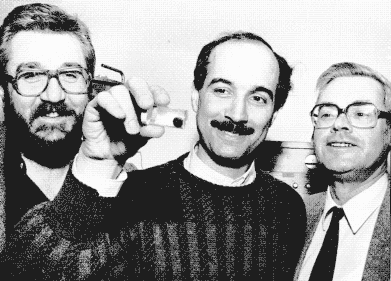The first Canadian high-Tc superconductor

Professors Mitrovic, Razavi, and Koffyberg with their high-Tc sample. 22.Dec.86
From the Brock University Media Release, 87/1, January 19, 1987:
Brock University Professors F.P. Koffyberg,
F.S. Razavi, and B. Mitrovic of the Physics
Department, Division of Maths and Sciences, have proven the existence
of a new superconductor.
Currently, superconductors are wires made from very brittle metal alloys
containing tin and niobium which must be cooled to 20 degrees absolute (-253
degrees Centigrade or -423 degrees Fahrenheit) using helium, a costly and
difficult coolant to handle.
The Brock University researchers have proven that a new
material becomes a superconductor at about 80 degrees absolute, a record
high temperature. This will mean that superconductivity can now be carried
out at a considerable savings in energy and therefore, money.
This substance, a compound of the metals barium, lanthanum, copper and
oxygen was prepared and measured for resistivity in the Brock University
Physics Laboratory. The measurement of its magnetic properties is proof of
its superconductivity.
The theory that such a substance might possibly be a superconductor was
postulated in a paper published by researchers working at the IBM
laboratories in Switzerland in early December, 1986. The Swiss researchers
had not, however, been able to prove their theory. Professor Razavi spotted the article and quickly
convinced his colleagues to try to prove what the Swiss lab had not. The
race was on.
Classes had just concluded for the Christmas break, leaving
Koffyberg,
Razavi, and Mitrovic
free to concentrate on the enormous task at hand. "When you have something
this hot, you drop everything," says the elated Koffyberg. Professor Mitrovic agrees, "It isn't often in one's
career that you come so close to the frontier."
The Brock research team immediately began work on the theory and by
December 22, 1986, had their proof. They have since been checking their
findings and preparing a paper which has been submitted to a prestigious
scientific journal, "Physical Review Letters", in the United States.
Professors Koffyberg,
Razavi, and Mitrovic have been racing
against research teams from Bell Laboratories in the United States, and the
IBM researchers in Switzerland and were neck and neck with their
competitors.
The research team of Koffyberg, Razavi and
Mitrovic is an interesting blend of
academic and cultural backgrounds. Professor Koffyberg, born in Holland
and educated at the Free University of Amsterdam, came to Canada originally
to work as a post-doctoral fellow at the National Research Council in
Ottawa. Professor Razavi, born in Tehran, began his university studies at
Meshed University in Iran and completed his doctorate at McMaster
University in Hamilton. Professor Mitrovic was born in Belgrade,
Yugoslavia, where he began his studies at the University of Belgrade. He
also completed his doctoral work at McMaster University in Hamilton.
|